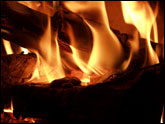Dear Umbra,
Can you shed some light (or some warmth) on the most environmentally sound ways to heat one’s home this winter? Natural gas over coal and oil for its lower carbon (and particulate) content? What about fireplaces: good or bad? Would burning gas logs be a good alternative to burning real wood? Thanks for your help!
Janet
Washington, D.C.
Dearest Janet,
What we cold eco-folks are looking for is a heat source that is clean to produce, clean to burn, energy-efficient, affordable, and renewable. Look back at your choices with that in mind, and you’ll see that natural gas, although imperfect, carries the day.
Coal has few upsides. It is not renewable, mining for it destroys land, water, and communities, and the power plants fueled by it are notorious polluters. Oil is another nonrenewable fuel that produces pollutants when burned. The toxic byproducts of oil- and coal-fired power plants, including methylmercury and arsenic, poison the air and groundwater. Meanwhile, pollutocrats are weakening the air-pollution regulations meant to promote stricter standards at such plants, meaning the future of cleaner energy generation from traditional sources continues to look dim.
Natural gas is also a non-renewable fossil fuel, but it burns more cleanly, producing less than half the carbon emissions of coal. It does contribute to smog and acid rain through the formation of nitrogen oxides, and is itself a greenhouse gas (methane). Still, gas is a better option than coal and oil, and if those are your choices, gas is the winner.
It’s not clear from your question whether you are buying electricity produced by a fuel-burning utility, or whether you are choosing between inviting these three fossil fuels into your own home with an oil furnace, a gas furnace or … does anyone burn coal at home these days? Ideally you would be able to buy green power from your utility (some provide this option, usually for a slightly elevated rate; ask your local energy companies), or install a greener heating system in your home. Solar, wind, even the exotic heat pump, which transforms heat from the great outdoors into heat in your living room, all spring to mind.

Log-tied.
As for fireplaces — in the modern lifestyle (by which I refer to anything after the invention of the wood stove), these are primarily decorative, not functional. Wood can be renewable, and it sure as heck is scenic, cozy, traditional, hip, makes you feel like a country stud, whatever — but burning it results in particulate matter flying up into the cold air, gagging innocent children and small woodland animals. So choose another fuel to stock the hearth, such as natural gas “logs.” Incredibly, those fake logs made from wax and sawdust burn more cleanly than real wood.
Many of us — especially the renters — are stuck with the heating system we inherited when we came into our current domicile, until that system fails or we get flush with cash. For those burdened with an inefficient, expensive, and/or polluting heating system and no way to change it, the most environmentally sound way to heat one’s home this winter is: less. Also, the drafts in most homes are cumulatively equivalent to leaving a window wide open. Filling holes and cracks, insulating walls, windows, and doors, and turning down the heat whenever you can are heat-conservation basics I am obliged to mention.
Heatedly,
Umbra


